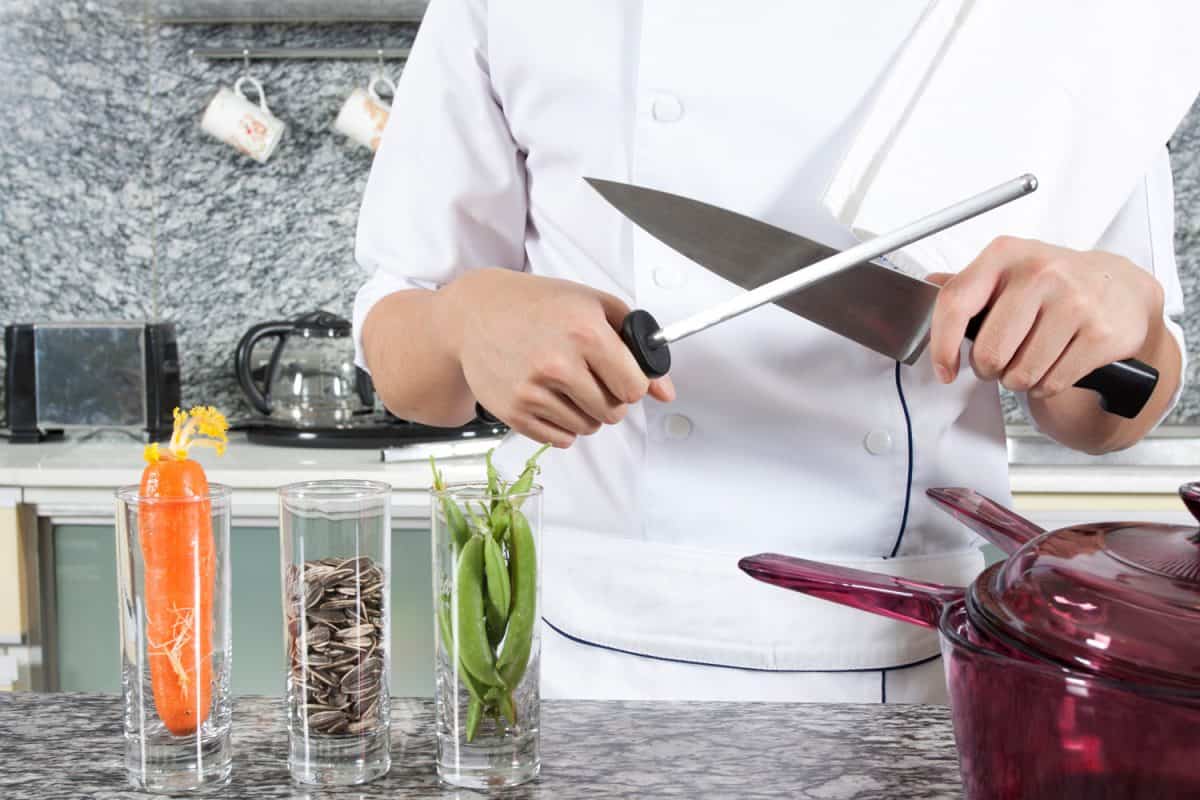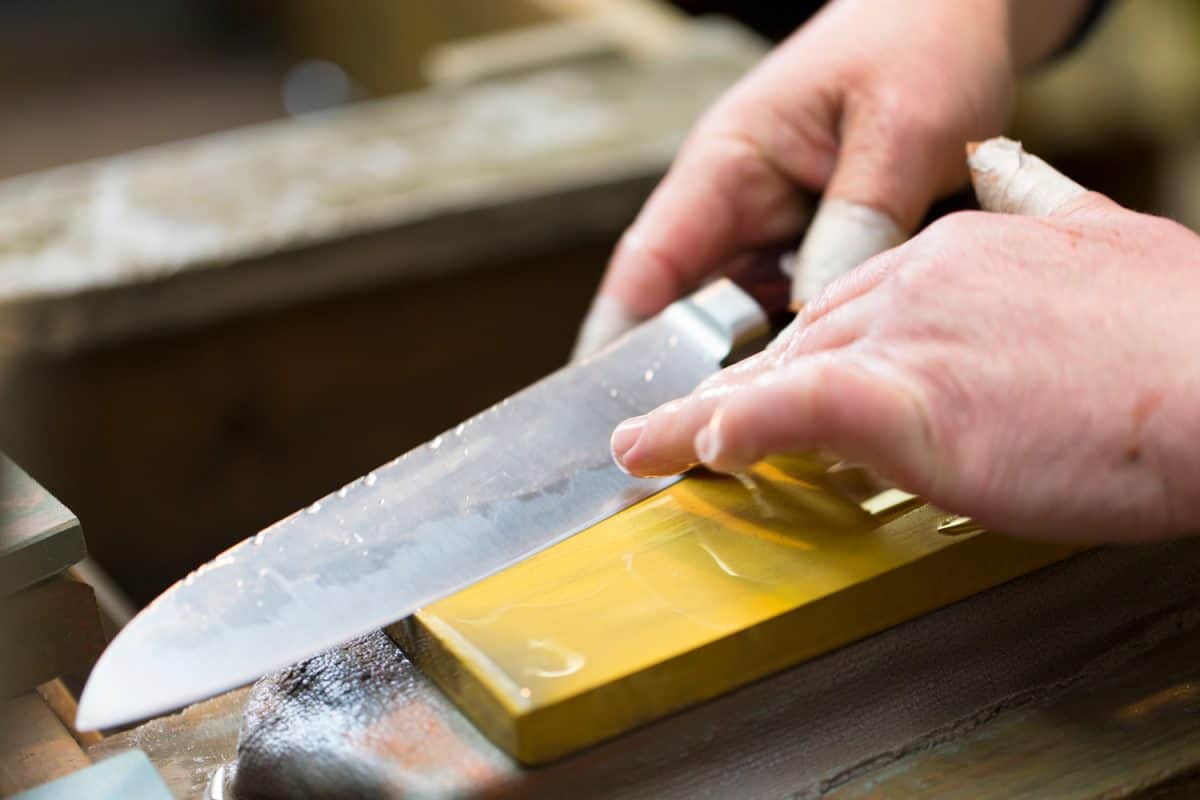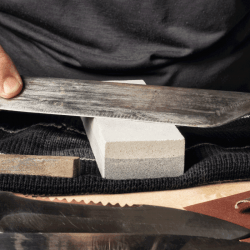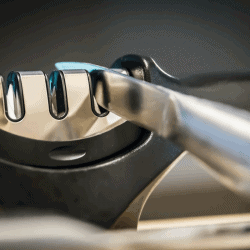After a while, your kitchen knife will start getting dull. To fix this, you'd go to your knife sharpener and make it perform as well as new! But, along the way, you might get the idea that your knife sharpener will also wear out. Is this a possibility, and when will we need to replace it? If that's what you're wondering, let's find out!
The answer depends on the type of sharpener you are using. For example, honing steel will never wear out. Likewise, ceramic sharpening steels can last you a long while. On the other hand, diamond sharpening steels do have the potential to wear out. In these cases, it depends on how well you maintain the tool.
The example above is a general idea of how long sharpeners can last. Of course, if you want to know about your situation specifically, you'd have to identify what type of sharpener you're using. There are many more options of sharpeners that don't include steel. If you'd like to find out more, keep reading ahead.
![knife and old iron sharpener with handle for kitchen knives on a white background, Do Knife Sharpeners Wear Out? [And When To Replace Yours]](https://kitchenseer.com/wp-content/uploads/2021/09/Do-Knife-Sharpeners-Wear-Out-And-When-To-Replace-Yours.png)
How Long Is a Knife Sharpener Good For?
A knife sharpener is good for as long as the user takes care of it.
However, in some cases, user responsibility may not have any effect on its durability. For example, honing steels are meant to last forever. Let's take a deeper look into honing steel first.

Honing Steel
Click here to see this honing steel on Amazon.
Honing steels are commonly referred to as knife sharpeners. You might see it included in their name on websites like Amazon.
The truth of the matter is that honing steels do not sharpen the knife. For that reason, it does not wear out.
Honing vs. Sharpening
There's a difference between honing and sharpening. Sharpening a knife means removing some of the knife's material to produce a new sharp edge.
In contrast, honing it does not get rid of any material. Instead, what you're doing is realigning the blade to the center.
If your blade shows signs of chipping or other types of damage, that's when you'd require sharpening over honing.
Honing allows the knife to get back to the original geometry the knife had. So, that sharpening effect you might notice after honing the blade is not actually sharpening.
Honing steels run against the edge of your blade at a consistent angle. All in all, you won't have to worry about replacing it any time soon.
Variations
Like most kitchenware nowadays, there's always another variation of it. In our case, there are ceramic and diamond honing steels.
They work similar to standard steel, but they also have the benefit of sharpening. Or, at the very least, a fine sharpener.
Ceramic and diamond steels do make minimal alterations to the blade. Though, they're still not as effective as an actual sharpener. Regardless, these types of steel do wear out.
Diamond Steel
Regarding the diamond-coated steel, the abrasive surface will dislodge over time. As a result, you will notice a decrease in its effectiveness.
Ceramic honing steels are a tricky situation. It shouldn't wear out ideally. But, if you don't take care of it well enough, it can become damaged.
Ceramic Steel
Ceramic steel is brittle. So, you have to handle it with care. As some users suggest, the ceramic pores will become clogged with metal particles.
Once they're bumping on other hard surfaces, the ceramic part can begin to chip. Though, that doesn't fall under standard use.
When to Replace Ceramic or Diamond Steel
In general, ceramic honing steel should last you a long while. You might not even have to replace it at all in your lifetime.
Though, if the ceramic begins to chip from mishandling, that's when you should consider replacing it.
Diamond honing steel should last you anywhere from 5-15 years. The longevity depends on how frequently you use it.
If it's under frequent use, you will have to replace it in 5-10 years. With infrequent use, it can last you a decade or more.
Though, once it no longer sharpens your knife, it's time to look for a replacement. In this situation, it means enough tiny diamond particles have scraped off of the steel.
So, you're more likely honing the knife instead of honing and fine sharpening.
Water Stones

If you're familiar with sharpening already, you might already know what options you have regarding sharpening your knife.
We know now that honing is not the same as sharpening. In which case, we'll have to look towards a water stone to do the job. Water stones, also known as whetstones, do wear out.
The mileage, once again, depends on how frequently you will use it. As some suggest, whetstones wear down regardless of their material.
The whetstone self-fractures naturally. As a result, you'll witness some areas of the surface hollowing out. For this reason, flattening the whetstone is a necessity.
When to Replace One
Replacing a whetstone depends on your expertise and how unevenness of the whetstone. Does it hollow out too much? Do you have enough experience to flatten it? If you answer no, you should probably get a new one.
Otherwise, you should flatten the surface using a fixing stone. If you flatten the surface and sharpen your knife, it might still end up dull. At this point, look into replacing the stone.
Why Is My Knife Dull After Sharpening?

The answer to this depends on several factors. Once again, it might get annoying at this point, but it depends on how you're sharpening the blade.
As you can see, the running theme is that it depends on the user. When sharpening, you will have to more attention to detail to your technique.
Another aspect you have to consider is what you're doing with the knife after sharpening.
As one culinary enthusiast suggests, washing a knife in the dishwasher or storing it with other sharp knives can make it dull quickly. Additionally, the cutting board you use plays a role in how quickly your knife dulls.
If it's your first time sharpening, you should practice sharpening with a knife that you don't mind ruining. This way, you get the experience you need to sharpen efficiently.
It's a great way to "sharpen" your skills without messing up one of the more expensive knives. To give you a start, here's a YouTube video demonstrating how to sharpen a knife with a whetstone:
Is There a Knife That Never Needs Sharpening?
Keeping a knife sharp is a lifelong dream for any aspiring chef. It can also be something that anyone who cooks regularly wants.
Sharpening is a delicate and time-consuming process. So, what if we can skip ahead and get a knife that doesn't need us to do that?
Unfortunately, no, it's still a dream. There's a lot that goes on when you're cooking.
In that process, you'll experience warping, chipping, or jaggedness on your knife. However, if you want the best of the best, you'll have to look for knives that you can actually sharpen.
If you want sharp cuts instead of tears or shredding, some recommend using the following types of knives:
- Serrated knives
- Ceramic knives
- Knives treated with hard metals
The Pros and Cons
Of course, like any other tool, they come with their own set of pros and cons.
For example, serrated knives aren't your typical kitchen knife. They have a serrated edge that's similar to a saw blade. Serrated knives require sharpening but not as frequently as standard kitchen knives.
Ceramic knives have a competitive edge, literally. In general, you won't have to sharpen a ceramic knife. It is wear-resistant.
So, it will serve you for a long time in comparison to a standard kitchen knife. But, like ceramic honing steel, it's brittle.
If you don't handle it with care, the edges can chip easily. In essence, it's crucial to handle ceramic products with extra care.
You should consider ceramic knives if you're confident you won't use them on other hard surfaces. For example, you should avoid using one on a glass cutting board or countertops.
Can a Kitchen Knife Be Too Sharp?

Since the process of sharpening can be a burden, you might want to "oversharpen" your knife to get more use out of it. It begs the question, can a kitchen knife be too sharp?
The consensus is that a knife can never be too sharp.
The sharper it is, the better. However, some forum users suggest that it can be too sharp for a given use.
This means that it might be more dangerous depending on the situation. For example, if you're cutting a sandwich in half on a paper plate while it's on your lap, you run the risk of cutting yourself.
If you want to keep one knife sharper than another, you should only use it for specific situations. This way, you won't accidentally cut yourself.
Final Takeaway
![knife and old iron sharpener with handle for kitchen knives on a white background, Do Knife Sharpeners Wear Out? [And When To Replace Yours]](https://kitchenseer.com/wp-content/uploads/2021/09/knife-and-old-iron-sharpener-with-handle-for-kitchen-knives-on-a-white-background-1200x800.jpg)
When you start taking the kitchen seriously, there's a lot of tools that come into play.
Kitchen sharpeners are one of the most useful ones out there. But, like any other tool, we have to know when we should replace one. We hope you found the information above insightful.
Before you go, do you have other knife concerns? Do you want to learn how to sharpen a serrated bread knife? You can find out out how by checking out our post here.
Do you have a built-in knife sharpener? Are you confused as to how to use one? You can learn how by checking out our post here.
Until next time!








WHAT ABOUT A WHETSTONE WITH A HANDLE?
Very informative. Most people definitely get confused between honing and sharpening knife. Just a question, I know that it depends on how you use it, but how long do whetstones usually last?